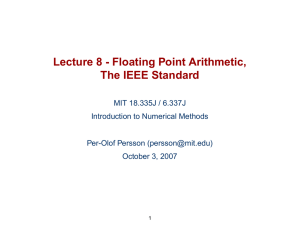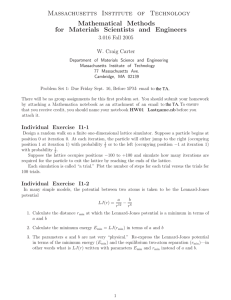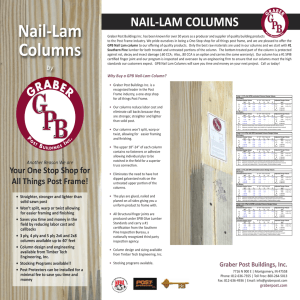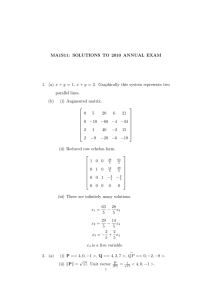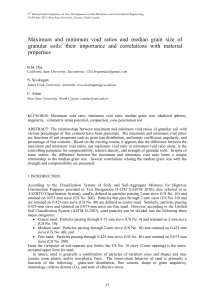Document 13575393
advertisement
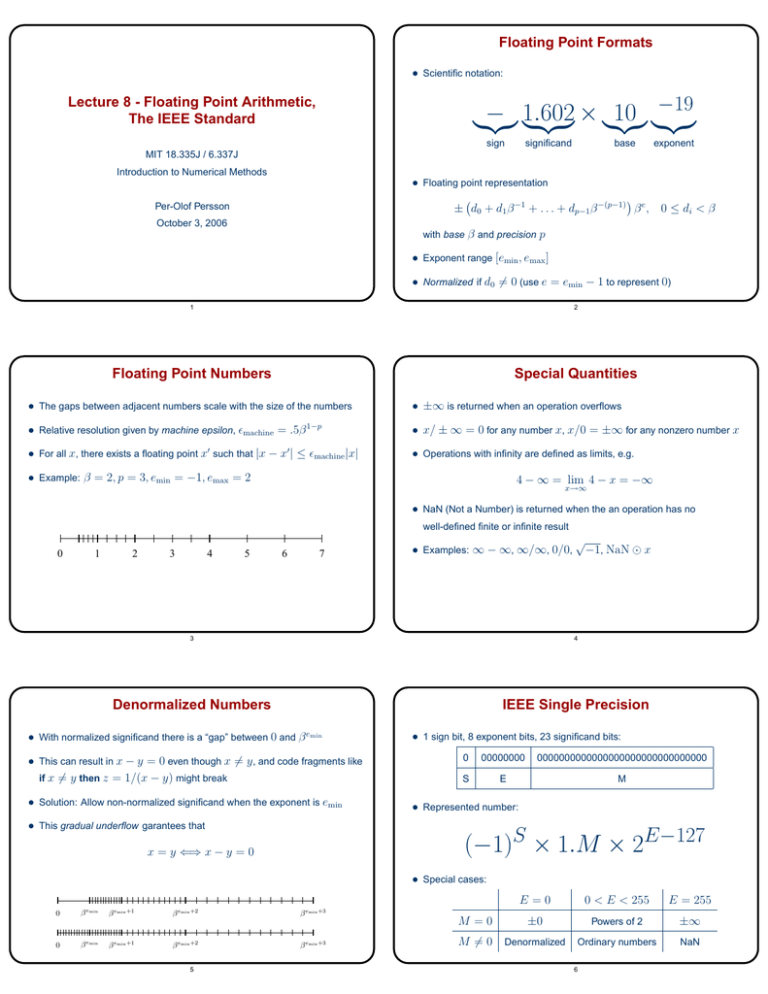
Floating Point Formats • Scientific notation: −19 − 1.602 10 ���� � �� � × ���� ���� Lecture 8 - Floating Point Arithmetic, The IEEE Standard significand sign MIT 18.335J / 6.337J Introduction to Numerical Methods base exponent • Floating point representation � � ± d0 + d1 β −1 + . . . + dp−1 β −(p−1) β e , 0 ≤ di < β Per-Olof Persson October 3, 2006 with base β and precision p • Exponent range [emin , emax ] • Normalized if d0 = � 0 (use e = emin − 1 to represent 0) 1 2 Floating Point Numbers Special Quantities • The gaps between adjacent numbers scale with the size of the numbers • ±∞ is returned when an operation overflows • Relative resolution given by machine epsilon, ǫmachine = .5β 1−p • x/ ± ∞ = 0 for any number x, x/0 = ±∞ for any nonzero number x • For all x, there exists a floating point x′ such that |x − x′ | ≤ ǫmachine |x| • Operations with infinity are defined as limits, e.g. • Example: β = 2, p = 3, emin = −1, emax = 2 4 − ∞ = lim 4 − x = −∞ x→∞ • NaN (Not a Number) is returned when the an operation has no well-defined finite or infinite result 0 1 2 3 4 5 6 7 • Examples: ∞ − ∞, ∞/∞, 0/0, √ −1, NaN ⊙ x 3 4 Denormalized Numbers IEEE Single Precision • With normalized significand there is a “gap” between 0 and β emin • This can result in x − y = 0 even though x �= y , and code fragments like if x �= y then z = 1/(x − y) might break • Solution: Allow non-normalized significand when the exponent is emin • This gradual underflow garantees that • 1 sign bit, 8 exponent bits, 23 significand bits: 0 00000000 0000000000000000000000000000000 S E M • Represented number: (−1)S × 1.M × 2E−127 x = y ⇐⇒ x − y = 0 • Special cases: 0 0 β emin β emin β emin +1 β emin +1 β emin +2 β emin +2 5 β emin +3 β emin +3 M =0 E=0 0 < E < 255 E = 255 ±0 Powers of 2 ±∞ M �= 0 Denormalized Ordinary numbers 6 NaN IEEE Floating Point Data Types IEEE Single Precision, Examples S E M Quantity 0 11111111 00000100000000000000000 NaN 1 11111111 00100010001001010101010 NaN 0 11111111 00000000000000000000000 ∞ 0 10000001 10100000000000000000000 +1 · 2129−127 · 1.101 = 6.5 +1 · 2 128−127 · 1.0 = 2 0 10000000 00000000000000000000000 0 00000001 00000000000000000000000 +1 · 21−127 · 1.0 = 2−126 0 00000000 10000000000000000000000 +1 · 2−126 · 0.1 = 2−127 0 00000000 00000000000000000000001 +1 · 2−126 · 2−23 = 2−149 0 00000000 00000000000000000000000 0 1 00000000 00000000000000000000000 −0 1 10000001 10100000000000000000000 −1 · 2129−127 · 1.101 = −6.5 1 11111111 00000000000000000000000 −∞ 7 • Define fl(x) as the closest floating point approximation to x • By the definition of ǫmachine , we have for the relative error: ∈ R, there exists ǫ with |ǫ| ≤ ǫmachine such that fl(x) = x(1 + ǫ) • The result of an operation ⊛ using floating point numbers is fl(a ⊛ b) • If fl(a ⊛ b) is the nearest floating point number to a ⊛ b, the arithmetic rounds correctly (IEEE does), which leads to the following property: For all floating point x, y , there exists ǫ with |ǫ| x ⊛ y = (x ∗ y)(1 + ǫ) • Round to nearest even in the case of ties 9 Double precision Significand size (p) 24 bits 53 bits Exponent size 8 bits 11 Total size 32 bits 64 bits emax +127 +1023 emin -126 Smallest normalized 2 Largest normalized 2127 ≈ 1038 ǫmachine 2−24 ≈ 6 · · · 10−8 −126 -1022 ≈ 10 −38 8 Floating Point Arithmetic For all x Single precision ≤ ǫmachine such that 2−1022 ≈ 10−308 21023 ≈ 10308 2−53 ≈ 10−16 MIT OpenCourseWare http://ocw.mit.edu 18.335J / 6.337J Introduction to Numerical Methods Fal l 2010 For information about citing these materials or our Terms of Use, visit: http://ocw.mit.edu/terms.
